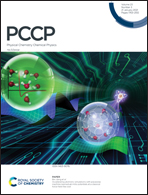A DFT-based microkinetic study on methanol synthesis from CO2 hydrogenation over the In2O3 catalyst†
Abstract
In this work, we performed density functional theory (DFT)-based microkinetic simulations to elucidate the reaction mechanism of methanol synthesis on two of the most stable facets of the cubic In2O3 (c-In2O3) catalyst, namely the (111) and (110) surfaces. Our DFT calculations show that for both surfaces, it is difficult for the H atom adsorbed at the remaining surface O atom around the O vacancy (Ov) active site to migrate to an O adsorbed at the Ov due to the very high energy barrier involved. In addition, we also find that the C–O bond in the bt-CO2* chemisorption structure can directly break to form CO with a lower energy barrier than that in its hydrogenation to the COOH* intermediate in the COOH route. However, our microkinetic simulations suggest that for both surfaces, CO2 deoxygenation to form CO in both pathways, namely the COOH and CO–O routes, are kinetically slower than methanol formation under typical steady state conditions assuming a CO2 conversion of 10% and a CO selectivity of 1%. Although these results agree with previous experimental observations at relatively low reaction temperature, where methanol formation dominates, they cannot explain the predominant formation of CO at relatively high reaction temperature. We tentatively attribute this to the simplicity of our microkinetic model as well as possible structural changes of the catalyst at relatively high reaction temperature. Furthermore, although the rate-determining step (RDS) from the degree of rate control (DRC) analysis is usually consistent with that judged from the DFT calculated energy barriers, for CO2 hydrogenation to methanol over the (111) surface, our DRC analysis suggests homolytic H2 dissociation to be the rate-controlling step, which is not apparent from the DFT-calculated energy barriers. This indicates that CO2 conversion and methanol selectivity over the (111) surface can be further enhanced if homolytic H2 dissociation can be accelerated for instance by introducing transition metal dopants as already shown by some experimental observations.

- This article is part of the themed collection: 2021 PCCP HOT Articles


 Please wait while we load your content...
Please wait while we load your content...